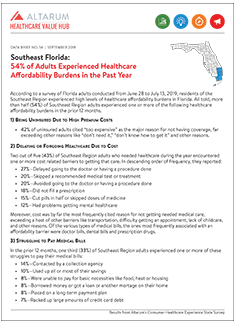Southeast Florida: 54% of Adults Experienced Healthcare Affordability Burdens in the Past Year
According to a survey of Florida adults conducted from June 28 to July 13, 2019, residents of the Southeast Region experienced high levels of healthcare affordability burdens in Florida. All told, more than half (54%) of Southeast Region adults experienced one or more of the following healthcare affordability burdens in the prior 12 months.
1) Being Uninsured Due to High Premium Costs
- 42% of uninsured adults cited “too expensive” as the major reason for not having coverage, far exceeding other reasons like “don’t need it,” “don’t know how to get it” and other reasons.
2) Delaying or Forgoing Healthcare Due to Cost
Two out of five (43%) of Southeast Region adults who needed healthcare during the year encountered one or more cost related barriers to getting that care. In descending order of frequency, they reported:
- 27%—Delayed going to the doctor or having a procedure done
- 20%—Skipped a recommended medical test or treatment
- 20%—Avoided going to the doctor or having a procedure done
- 18%—Did not fill a prescription
- 15%—Cut pills in half or skipped doses of medicine
- 12%—Had problems getting mental healthcare
Moreover, cost was by far the most frequently cited reason for not getting needed medical care, exceeding a host of other barriers like transportation, difficulty getting an appointment, lack of childcare, and other reasons. Of the various types of medical bills, the ones most frequently associated with an affordability barrier were doctor bills, dental bills and prescription drugs.
3) Struggling to Pay Medical Bills
In the prior 12 months, one third (33%) of Southeast Region adults experienced one or more of these struggles to pay their medical bills:
- 14%—Contacted by a collection agency
- 10%—Used up all or most of their savings
- 8%—Were unable to pay for basic necessities like food, heat or housing
- 8%—Borrowed money or got a loan or another mortage on their home
- 8%—Placed on a long-term payment plan
- 7%—Racked up large amounts of credit card debt
High Levels of Worry About Affording Healthcare in the Future
Residents of the Southeast Region reported high levels of worry about affording healthcare in the future. Four out of five (79%) respondents reported being “worried” or “very worried” about one or more of these topics: affording nursing home and home care services (62%); prescription drug costs (59%); costs when elderly (58%); cost of a serious illness or accident (57%); health insurance becoming too expensive (57%); and losing health insurance (39%).
Dissatisfaction with the Health System and Support for Change
Residents of the Southeast Region of Florida were extremely dissatisfied with the health system. Just 29% agreed or strongly agreed with the statement “We have a great healthcare system in the U.S.,” while 62% agreed or strongly agreed with “the system needs to change.”
Respondents do see a role for themselves in solving problems. They reported actions they have already taken, like researching the cost of a drug beforehand (65%), as well as actions they should be taking—62% believe that taking better care of their personal health is one of the top things they can do personally to address affordability.
But in far greater numbers they saw a role for their elected representatives. Examples of strategies that received support across party lines included (Total/Republican/Democrat/Neither):
- Make it easy to switch insurers if a health plan drops your doctor—(86%/90%/85%/85%)
- Authorize the attorney general to take legal action to prevent price gouging or unfair prescription drug price hikes—(85%/84%/87%/83%)
- Show what a fair price would be for specific procedures—(83%/82%/82%/86%)
- Require insurers to provide upfront cost estimates to consumers—(82%/94%/82%/73%)
The high burden of healthcare affordability along with high levels of support for change suggest that elected leaders and other stakeholders need to make addressing the cost of healthcare a top priority. Annual surveys can help assess whether or not progress is being made.
Note: For survey methodology and state-wide data, see https://healthcarevaluehub.org/Florida-2019-Healthcare-Survey







